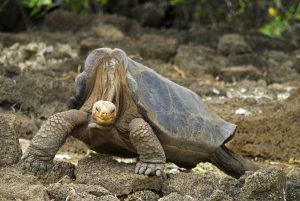Pinta Island is a volcanic island in the northern part of the Galapagos Archipelago. Its many volcanic fissures mean that the arid region possesses a somewhat dangerous beauty. It is the ninth largest of the 19 islands in the archipelago.
Even though the island is just 60 square kilometres, it has some of the widest variety of wildlife in the area.
The Island’s Flora and Fauna
Due to the many young volcanoes, the island has very sparse vegetation. Much of what was left was devastated by feral goats that were introduced to the island in 1950. This diminished the food for the native tortoises, and there was a successful movement to exterminate them.

Pinta Island is also home to Galapagos hawks, fur seals, swallow-tailed gulls, marine iguanas, Galapagos fur seals blue-tailed boobies and sparrowhawks. However, the most famous resident of the island were the Pinta Island Tortoises a subspecies of the Galapagos tortoise.
Whalers and pirates destroyed most of the tortoise population, leaving behind one survivor, who was called Lonesome George. Numerous attempts at mating George over the decades were all unsuccessful and he eventually dies in 2012. His body was preserved at the American Museum of Natural History in New York City and was eventually put on display at the Charles Darwin Research Station on Santa Cruz Island.
Pinta Island’s History
Pinta Island was named after one of Columbus’s ships. It is also known as Abingdon Island, after the Earl of Abingdon. It was discovered by the Spanish Bishop, Tomas de Berlanga, in the 15th century. But, its bleak landscape meant that it was never colonised.

In the 17th century, the island was used as a hiding spot for pirates, and in the 18th century as a stopping point for whalers. Both the pirates and whalers caused widespread devastation to the island’s wildlife, especially the Galapagos tortoise.
Travelling to Pinta Island
Though the island has many landing sites, the arid landscape means that there is little to see. Also, after the eradication of the feral goats, Pinta Island’s biodiversity is slowly recovering. These conservation efforts mean that the island is largely closed to visitors. Scientists and researchers can obtain special permission from the Ecuador government to visit the island. However, make sure not to miss the other amazing islands of the Galapagos.
Read more: The other Islands of the Galapagos.